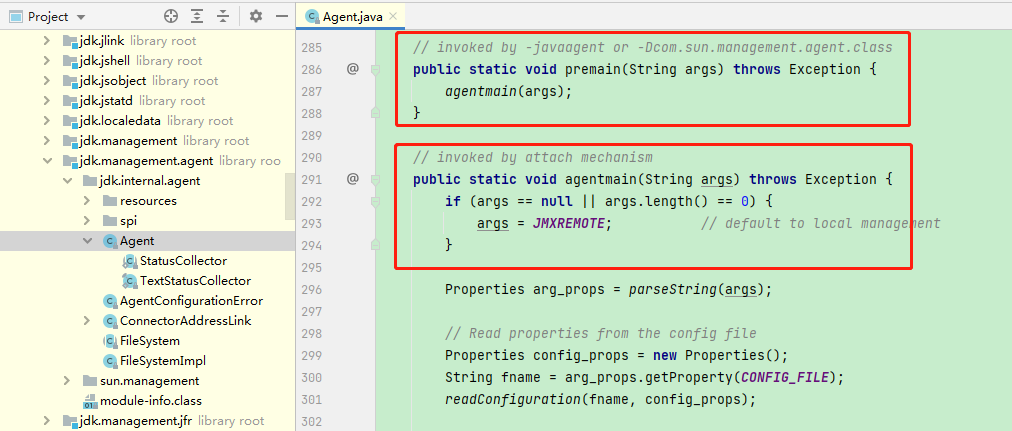什么是Java反射机制?
Java反射机制是 Java 语言的一个重要特性,它在服务器程序和中间件程序中得到了广泛运用。在服务器端,往往需要根据客户的请求,动态调用某一个对象的特定方法。此外,在 ORM 中间件的实现中,运用 Java 反射机制可以读取任意一个 JavaBean 的所有属性,或者给这些属性赋值
通过反射机制,可以在运行的时候访问到对象的属性、方法、构造方法等等
哪些地方用到反射机制?
其实我们都用过反射机制,只是并不知道它是反射机制而已。比如我们使用JDBC连接数据库的时候(Class.forName() 这个相信大家都用过),只是当时并没有在意那么多(心里想能用就行,管它呢),使用到反射机制的框架有(Spring、SpringMVC、Mybatis、Hibernate、Structs)
反射机制提供了哪些功能?
在运行时判定任意一个对象所属的类
在运行时构造任意一个类的对象
在运行时判定任意一个类所具有的成员变量和方法
在运行时调用任意一个对象的方法
生成动态代理
如何实现反射机制?
先来个实体类 Student
/**
* @author Woo_home
* @create by 2019/12/10
*/
public class Student {
private int id;
private String name;
public Student(){}
public int getId() {
return id;
}
public void setId(int id) {
this.id = id;
}
public String getName() {
return name;
}
public void setName(String name) {
this.name = name;
}
@Override
public String toString() {
return "Student{" +
"id=" + id +
", name='" + name + ''' +
'}';
}
}
反射的三种实现方式
一、通过对象的getClass()方法
getClass()方法是Object类的方法,因为所有类都继承自Object类,所以可以直接使用getClass()方法
public class ReflectDemo {
public static void main(String[] args) {
Student student = new Student();
Class studentClass = student.getClass();
System.out.println(studentClass);
}
}
二、通过类的.class属性
直接获取一个类的class
public class ReflectDemo {
public static void main(String[] args) {
Class studentClass = Student.class;
System.out.println(studentClass);
}
}
三、通过Class类的forName()方法(常用)
Class.forName() 是一个静态方法
public class ReflectDemo {
public static void main(String[] args) {
// 使用 try、catch 处理异常
try {
Class studentClass = Class.forName("com.example.app.demo.Student");
System.out.println(studentClass);
}catch (ClassNotFoundException e){
e.printStackTrace();
}
}
}
public class ReflectDemo {
// 使用 throws 处理异常
public static void main(String[] args) throws ClassNotFoundException{
Class studentClass = Class.forName("com.example.app.demo.Student");
System.out.println(studentClass);
}
}
三种方法打印的结果都是一样的,如下图所示
注意: 这里的Class.forName()方法需要使用try、catch语句括住或者在方法或类中抛出ClassNotFoundException 异常,不然会报错
有些人就问了,为什么需要使用try、catch语句括住呢,来看下forName方法源码:
可以看到forName需要抛出一个 ClassNotFoundException 异常,自然而然地你使用forName()方法也自然要抛出 / 处理日常了
@CallerSensitive
public static Class forName(String className)
throws ClassNotFoundException {
Class caller = Reflection.getCallerClass();
return forName0(className, true, ClassLoader.getClassLoader(caller), caller);
}
判断一个类是否为某个类的实例
1、instanceof
public class ReflectDemo {
public static void main(String[] args) {
HashMap
if (map instanceof Map){
System.out.println("HashMap is Map instance");
}
}
}
输出:HashMap is Map instance
2、isInstance
public class ReflectDemo {
public static void main(String[] args) {
HashMap
if (Map.class.isInstance(map)){
System.out.println("HashMap is Map Instance");
}
}
}
输出:HashMap is Map Instance
利用反射创建对象实例
1、通过Class对象的 newInstance() 方法
public class ReflectDemo {
public static void main(String[] args) throws IllegalAccessException, InstantiationException {
// 这里的Student是使用上面一开始的Student类
Class studentClass = Student.class;
// 使用newInstance创建实例
Student student = (Student)studentClass.newInstance();
student.setId(1);
student.setName("John");
System.out.println(student);
}
}
输出:John
2、通过Constructor对象的 getConstructor() 方法
public class ReflectDemo {
public static void main(String[] args) throws NoSuchMethodException, IllegalAccessException, InvocationTargetException, InstantiationException {
Class classes = List.class;
Constructor constructor = classes.getConstructor(List.class);
List result = (List) constructor.newInstance("John");
System.out.println(result);
}
}
输出:John
Field
根据字段名获取字段(只能获取public的)
public class ReflectDemo {
public static void main(String[] args) throws NoSuchFieldException {
Class classes = Student.class;
Field id = classes.getField("id");
Field name = classes.getField("name");
System.out.println(id);
System.out.println(name);
}
}
class Student{
public int id;
public String name;
}
输出:
以下为输出结果
public int com.example.app.demo.Student.id
public java.lang.String com.example.app.demo.Student.name
如果获取的字段是被private修饰的,那么将会抛出 NoSuchFieldException 异常
以下为输出结果
Exception in thread “main” java.lang.NoSuchFieldException: id
at java.lang.Class.getField(Class.java:1703)
at com.example.app.demo.ReflectDemo.main(ReflectDemo.java:12)
为什么会这样呢?我们朝着这个问题看下源码是怎么实现的
getField(String name)
根据名称获取公有的(public)类成员
@CallerSensitive
public Field getField(String name)
throws NoSuchFieldException, SecurityException {
checkMemberAccess(Member.PUBLIC, Reflection.getCallerClass(), true);
// 可以看到在getField传入的name实际是调用getField0来实现的
Field field = getField0(name);
if (field == null) {
throw new NoSuchFieldException(name);
}
return field;
}
getField0(String name)
而getField0主要判断依据是searchFields,searchFields根据privateGetDeclaredFields判断
private Field getField0(String name) throws NoSuchFieldException {
Field res;
// Search declared public fields
if ((res = searchFields(privateGetDeclaredFields(true), name)) != null) {
return res;
}
// 省略部分代码...
return null;
}
privateGetDeclaredFields(boolean publicOnly)
可以看到当privateGetDeclaredFields传入的值是true的时候表示使用的是 declaredPublicFields ,也就是说是public声明的字段,当传入的值为false的时候使用的是 declaredFields(所有声明字段)
private Field[] privateGetDeclaredFields(boolean publicOnly) {
checkInitted();
Field[] res;
ReflectionData
if (rd != null) {
// 判断输入的布尔值是true还是false
res = publicOnly ? rd.declaredPublicFields : rd.declaredFields;
if (res != null) return res;
}
// 省略部分代码...
return res;
}
getFields(String name)
获取所有 public 修饰的字段
public class ReflectDemo {
public static void main(String[] args) throws NoSuchFieldException {
Class classes = Student.class;
Field[] allField = classes.getFields();
for (Field field : allField) {
System.out.println(field);
}
}
}
class Student{
private int id;
public String name;
}
输出:
以下为输出结果
public java.lang.String com.example.app.demo.Student.name
可以看到我们的Student类中声明了一个private修饰的id和一个public修饰的name,根据输出结果可以知道getFields()方法只能获取public修饰的字段
看下实现源码:
在getFields中返回了一个copyFields方法,该方法中调用了 privateGetPublicFields 方法
@CallerSensitive
public Field[] getFields() throws SecurityException {
checkMemberAccess(Member.PUBLIC, Reflection.getCallerClass(), true);
return copyFields(privateGetPublicFields(null));
}
来看下privateGetPublicFields方法可以知道在该方法中调用了 privateGetDeclaredFields(true) 这个方法,关于这个方法上面已经讲述过
private Field[] privateGetPublicFields(Set
// Local fields
Field[] tmp = privateGetDeclaredFields(true);
addAll(fields, tmp);
// 省略部分代码...
return res;
}
getDeclaredField(String name)
根据名称获取已声明的类成员。但不能得到其父类的类成员
public class ReflectDemo {
public static void main(String[] args) throws NoSuchFieldException {
Class classes = Student.class;
Field allField = classes.getDeclaredField("name");
System.out.println(allField);
}
}
class Student{
private int id;
private String name;
}
Class Student{
public int id;
public String name;
}
输出:可以看到getDeclaredField()方法即可以获取public类型的字段也能获取private类型的字段
以下为输出结果:
private java.lang.String com.example.app.demo.Student.name
public java.lang.String com.example.app.demo.Student.name
来看下源码的原理
@CallerSensitive
public Field getDeclaredField(String name)
throws NoSuchFieldException, SecurityException {
checkMemberAccess(Member.DECLARED, Reflection.getCallerClass(), true);
Field field = searchFields(privateGetDeclaredFields(false), name);
if (field == null) {
throw new NoSuchFieldException(name);
}
return field;
}
可以看到 getDeclaredField() 方法调用的也是 privateGetDeclaredFields 方法,上面已经讲述过
getDeclaredFields()
获取所有已声明的类成员变量
public class ReflectDemo {
public static void main(String[] args) {
Class classes = Student.class;
Field[] allField = classes.getDeclaredFields();
for (Field field : allField) {
System.out.println(field);
}
}
}
class Student{
public int id;
public String name;
}
输出:
以下为输出结果:
public int com.example.app.demo.Student.id
public java.lang.String com.example.app.demo.Student.name
而且 getDeclaredFields 还可以获取private修饰的字段
public class ReflectDemo {
public static void main(String[] args) {
Class classes = Student.class;
Field[] allField = classes.getDeclaredFields();
for (Field field : allField) {
System.out.println(field);
}
}
}
class Student{
private int id;
private String name;
}
输出:
以下为输出结果:
private int com.example.app.demo.Student.id
private java.lang.String com.example.app.demo.Student.name
来看下源码 getDeclaredFields() 方法的源码
可以看到 getDeclaredFields() 方法中也是调用 privateGetDeclaredFields 方法的,并且这里的 privateGetDeclaredFields传入的值是 false ,也就是获取所有已声明的字段
@CallerSensitive
public Field[] getDeclaredFields() throws SecurityException {
checkMemberAccess(Member.DECLARED, Reflection.getCallerClass(), true);
return copyFields(privateGetDeclaredFields(false));
}
Method
getMethod(String name)
返回类或接口的特定方法。其中第一个参数为方法名称,后面的参数为方法参数对应 Class 的对象的方法名
public class ReflectDemo {
public static void main(String[] args) throws NoSuchMethodException {
// 传入CaseMethod的方法名
Method methods = CaseMethod.class.getMethod("caseOfMethod");
System.out.println(methods);
}
}
class CaseMethod{
public void caseOfMethod(){
System.out.println("case");
}
}
输出:
以下为输出结果:
public void com.example.app.demo.CaseMethod.caseOfMethod()
getMethods()
获取类或接口的所有 public 方法,包括其父类的 public 方法
public class ReflectDemo {
public static void main(String[] args) throws NoSuchMethodException {
// 获取所有方法,使用Method数组接收
Method[] methods = CaseMethod.class.getMethods();
for (Method method : methods) {
System.out.println(method);
}
}
}
class CaseMethod{
public void caseOfMethod(){
System.out.println("case");
}
}
输出:
可以看到输出结果中第一个就是我们自定义的CaseMethod中的方法,其余的都是Object类的方法
以下为输出结果:
public void com.example.app.demo.CaseMethod.caseOfMethod()
public final void java.lang.Object.wait() throws java.lang.InterruptedException
public final void java.lang.Object.wait(long,int) throws java.lang.InterruptedException
public final native void java.lang.Object.wait(long) throws java.lang.InterruptedException
public boolean java.lang.Object.equals(java.lang.Object)
public java.lang.String java.lang.Object.toString()
public native int java.lang.Object.hashCode()
public final native java.lang.Class java.lang.Object.getClass()
public final native void java.lang.Object.notify()
public final native void java.lang.Object.notifyAll()
getDeclaredMethod(String name, Class… parameterTypes)
获取类或接口的特定声明方法。其中第一个参数为方法名称,后面的参数为方法参数对应 Class 的对象
public class ReflectDemo {
public static void main(String[] args) throws NoSuchMethodException {
Method methods = CaseMethod.class.getDeclaredMethod("caseOfMethod",null);
System.out.println(methods);
}
}
class CaseMethod{
public void caseOfMethod(){
System.out.println("case");
}
private void caseOf(){
System.out.println("case1");
}
}
getDeclaredMethods()
获取类或接口声明的所有方法,包括 public、protected、默认(包)访问和 private 方法,但不包括继承的方法
public class ReflectDemo {
public static void main(String[] args) {
Method[] methods = CaseMethod.class.getDeclaredMethods();
for (Method method : methods) {
System.out.println(method);
}
}
}
class CaseMethod{
public void caseOfMethod(){
System.out.println("case");
}
private void caseOf(){
System.out.println("case1");
}
}
输出:
以下为输出结果:
public void com.example.app.demo.CaseMethod.caseOfMethod()
private void com.example.app.demo.CaseMethod.caseOf()
使用invoke方法
当获取一个对象之后就可以使用invoke方法,invoke方法示例如下:
public class ReflectDemo {
public static void main(String[] args) throws NoSuchMethodException, IllegalAccessException, InvocationTargetException {
Method methods = CaseMethod.class.getMethod("caseOfMethod");
CaseMethod caseMethod = new CaseMethod();
methods.invoke(caseMethod);
}
}
class CaseMethod{
public void caseOfMethod(){
System.out.println("case");
}
private void caseOf(){
System.out.println("case1");
}
}
输出:case
那么invoke是如何实现的呢?来看下源码
boolean override;
@CallerSensitive
public Object invoke(Object obj, Object... args)
throws IllegalAccessException, IllegalArgumentException,
InvocationTargetException
{
// 判断override是否为true
if (!override) {
// 判断modifiers(方法的修饰符)是否为public
if (!Reflection.quickCheckMemberAccess(clazz, modifiers)) {
// 通过方法的修饰符(protected、private、)或声明类(如子类可以访问父类的protected方法)与caller之间的关系
Class caller = Reflection.getCallerClass();
// 判断caller是否有权限方法该方法
checkAccess(caller, clazz, obj, modifiers);
}
}
MethodAccessor ma = methodAccessor; // read volatile
if (ma == null) {
ma = acquireMethodAccessor();
}
return ma.invoke(obj, args);
}
注意: invoke方法如果提供了错误的参数,会抛出一个异常,所以要提供一个异常处理器。建议在有必要的时候才使用invoke方法,有如下原因:
1、invoke方法的参数和返回值必须是Object类型,意味着必须进行多次类型转换
2、通过反射调用方法比直接调用方法要明显慢一些
Constructor
getConstructor(Class… parameterTypes)
获取类的特定 public 构造方法。参数为方法参数对应 Class 的对象
public class ReflectDemo {
public static void main(String[] args) throws NoSuchMethodException, IllegalAccessException, InvocationTargetException {
Constructor
System.out.println(constructor);
}
}
class CaseMethod{
private int id;
private String name;
private int cap;
public CaseMethod(int id,String name){
this.id = id;
this.name = name;
}
public CaseMethod(int cap){
}
}
输出:
以下为输出结果:
public com.example.app.demo.CaseMethod(int,java.lang.String)
getConstructors()
获取类的所有 public 构造方法
public class ReflectDemo {
public static void main(String[] args) {
Constructor[] constructors = CaseMethod.class.getConstructors();
for (Constructor constructor : constructors) {
System.out.println(constructor);
}
}
}
class CaseMethod{
private int id;
private String name;
private int cap;
public CaseMethod(int id,String name){
this.id = id;
this.name = name;
}
public CaseMethod(int cap){
}
}
输出:
以下为输出结果:
public com.example.app.demo.CaseMethod(int,java.lang.String)
public com.example.app.demo.CaseMethod(int)
getDeclaredConstructor(Class… parameterTypes)
public class ReflectDemo {
public static void main(String[] args) throws NoSuchMethodException {
// 注意:由于private修饰的CaseMethod构造函数没有参数,所以getDeclaredConstructor()可以为空
// 默认的getDeclaredConstructor(Class... parameterTypes)方法是要传参数类型的
Constructor
Constructor
System.out.println(constructor);
System.out.println(declaredConstructor);
}
}
class CaseMethod{
private int id;
private String name;
private int cap;
private CaseMethod(){
}
public CaseMethod(int id,String name){
this.id = id;
this.name = name;
}
}
输出:
以下为输出结果:
private com.example.app.demo.CaseMethod()
public com.example.app.demo.CaseMethod(int,java.lang.String)
getDeclaredConstructors()
获取类的所有构造方法
public class ReflectDemo {
public static void main(String[] args) throws NoSuchMethodException {
Constructor[] constructors = CaseMethod.class.getDeclaredConstructors();
for (Constructor constructor : constructors) {
System.out.println(constructor);
}
}
}
class CaseMethod{
private int id;
private String name;
private int cap;
private CaseMethod(){
}
public CaseMethod(int id,String name){
this.id = id;
this.name = name;
}
}
输出:
以下为输出结果:
private com.example.app.demo.CaseMethod()
public com.example.app.demo.CaseMethod(int,java.lang.String)
使用newInstance创建实例
public class ReflectDemo {
public static void main(String[] args) throws NoSuchMethodException, IllegalAccessException, InvocationTargetException, InstantiationException {
Constructor
CaseMethod caseMethod = constructor.newInstance("Lisa");
System.out.println(caseMethod);
}
}
class CaseMethod{
private String name;
public CaseMethod(String name){
this.name = name;
}
@Override
public String toString() {
return "CaseMethod{" +
"name='" + name + ''' +
'}';
}
}
输出:
CaseMethod{name=‘Lisa’}
总结
Java获得Class对象的引用的方法中,Class.forName() 方法会自动初始化Class对象,而 .class 方法不会,.class 的初始化被延迟到静态方法或非常数静态域的首次引用
-
服务器
+关注
关注
12文章
8099浏览量
82483 -
JAVA
+关注
关注
19文章
2904浏览量
102988 -
数据库
+关注
关注
7文章
3589浏览量
63363
发布评论请先 登录
相关推荐
共享单车到底是什么通信原理





 Java反射机制到底是什么?有什么作用
Java反射机制到底是什么?有什么作用

















评论